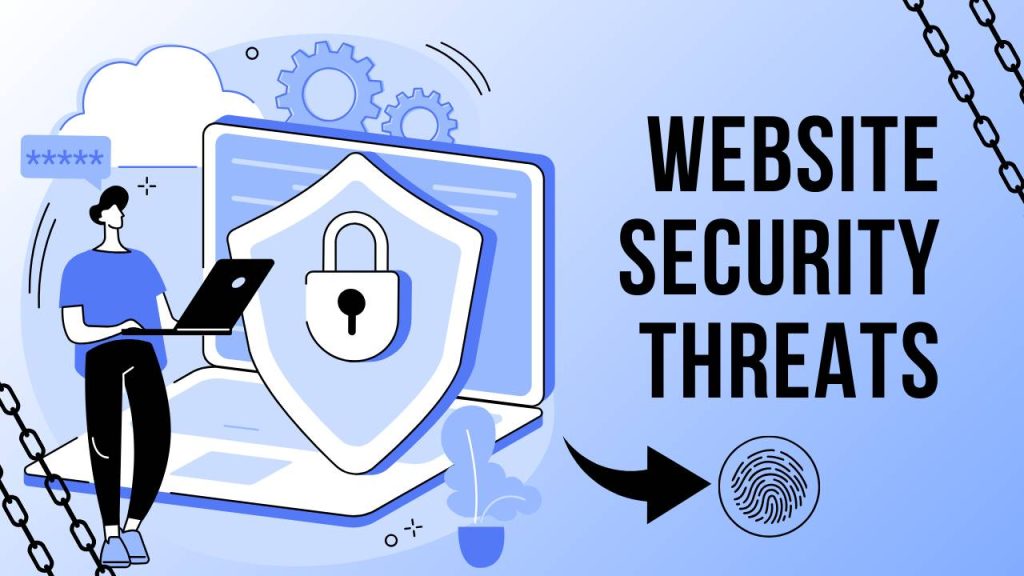Website owners, developers, and businesses are facing an unprecedented surge in cybersecurity risks. The digital world has turned increasingly hostile—not just because the number of attacks has risen, but because these attacks have grown more intelligent, scalable, and targeted.
Gone are the days of simple brute-force or spam-based intrusions. Today’s Website Security Threats are intelligent operations, orchestrated by skilled cybercriminal groups using advanced tools such as AI, automation, and real-time reconnaissance techniques.
Here are the most dangerous website security threats of 2025, explain how they work, and guide you on how to protect your web infrastructure.
Top Website Security Threats in 2025
1. AI-Powered Cyber Attacks – When Machines Become Hackers
Hackers now use Artificial Intelligence (AI) as a weapon. In 2025, AI-driven hacking tools autonomously scan websites, learn from failed attempts, and optimize attack strategies in real time. These tools mimic human behavior to avoid detection and operate with surgical precision.
These systems perform reconnaissance, identify vulnerabilities in login portals, outdated CMS components, or unpatched plugins, and execute silent attacks without setting off alarms. They test password patterns, analyze backend structures, and simulate regular traffic to remain invisible.
To defend against this level of threat, you must integrate AI-based cybersecurity solutions that can learn and adapt like the attackers’ tools. You should also conduct frequent behavior-based audits, implement anomaly detection systems, and use zero-trust frameworks that monitor every access request.
2. Website Ransomware – Your Site, Held Hostage
Website ransomware has evolved beyond targeting traditional computers—it now locks down entire websites. Hackers encrypt everything, including databases, front-end files, and backend systems, and then demand a ransom in cryptocurrency to restore access.
This type of attack can bring your operations to a standstill. For eCommerce websites or SaaS platforms, even a few hours of downtime leads to massive revenue loss and customer distrust. What’s worse, even after paying the ransom, many victims never regain full access.
To prevent ransomware disasters, back up your entire site regularly and store those backups in isolated environments. Deploy advanced endpoint protection, segment your networks, and use behavior-based threat detection to block suspicious activities before they escalate.
3. Zero-Day Vulnerabilities – Attacks You Never See Coming
Zero-day vulnerabilities are hidden flaws in your CMS, plugins, themes, or libraries that hackers exploit before developers release a fix. These are the most unpredictable website security threats because they strike without warning and leave little room for response.
Attackers use zero-days to inject malware, bypass authentication, or even gain full administrative access. These vulnerabilities can lurk in trusted software for months, silently exposing your data to malicious actors.
To minimize the risk, implement a proactive patch management strategy. Subscribe to security bulletins for your CMS, deploy virtual patching tools that temporarily shield flaws, and use application firewalls that can detect suspicious behavior patterns.
4. Credential Stuffing – Exploiting Password Reuse
Hackers now use credential stuffing as a primary way to breach websites. They rely on massive databases of previously leaked usernames and passwords and deploy bots to test those credentials across thousands of websites.
In 2025, credential stuffing bots can imitate human typing, change IP addresses frequently, and bypass traditional login rate limits and CAPTCHAs. These silent attacks often go unnoticed until the damage is already done—user accounts compromised, admin access gained, and sensitive information stolen.
To protect your users and data, enforce multi-factor authentication (MFA) on all login portals, apply intelligent rate limiting, and deploy tools that can identify and stop automated login attempts. Encourage your users to use password managers and never reuse passwords across different sites.
5. Supply Chain Attacks – When Your Vendors Get Compromised
Websites in 2025 rely heavily on third-party tools, APIs, plugins, and CDNs. Supply chain attacks take advantage of this trust. Instead of attacking your site directly, hackers compromise your external vendors and use them as a delivery mechanism for malware or unauthorized scripts.
For example, a compromised analytics script or JavaScript library can leak data, log keystrokes, or open a backdoor into your server. These attacks are difficult to detect because they exploit software and services you’ve already approved and integrated.
To reduce risk, use Subresource Integrity (SRI) for all third-party scripts, monitor third-party dependencies for new vulnerabilities, and adopt dependency-checking tools. Vet your vendors thoroughly and never blindly trust external updates without security audits.
6. Clone Sites & Domain Spoofing – Evolved Phishing Attacks
Phishing in 2025 is no longer about shady emails—it’s about full-fledged clone websites that look exactly like yours. These sites mimic your brand design, content, and user flow to trick visitors into sharing credentials or making fraudulent payments.
Attackers use domains that closely resemble yours (such as swapping an “l” for an “I”), obtain SSL certificates to appear legitimate, and even boost these fake pages through SEO or ads to gain visibility. Users often can’t tell the difference until it’s too late.
Combat these phishing attacks by registering similar domain names, using domain monitoring tools, and enabling DMARC, SPF, and DKIM protocols to prevent email spoofing. Educate users to double-check URLs and look for unusual behaviors before entering sensitive data.
7. DDoS Attacks – Overwhelming Your Website with Fake Traffic
Distributed Denial-of-Service (DDoS) attacks continue to be a popular and destructive tactic in 2025. Attackers use massive botnets to flood your website with fake requests, overwhelming your servers and crashing your site.
Modern DDoS attacks are more sophisticated. They simultaneously target application layers, DNS, and API endpoints, making them harder to mitigate with basic firewalls. These disruptions can last hours or even days and lead to revenue loss and brand damage.
To defend your infrastructure, use cloud-based DDoS protection solutions like Cloudflare or AWS Shield, implement rate limiting, and configure auto-scaling and load balancing. Diversify your server locations to absorb the traffic more efficiently.
8. Session Hijacking & Advanced XSS – Silent Exploit Tactics
Attackers use Cross-Site Scripting (XSS) and session hijacking to steal session cookies and impersonate users. XSS attacks inject malicious scripts that run in a user’s browser, while session hijacking gives attackers access to the user’s account without needing login credentials.
These attacks have become more subtle and sophisticated in 2025. They often bypass input sanitization, exploit DOM-based flaws, and avoid triggering basic security alerts.
You can prevent these by implementing strict Content Security Policies (CSP), validating and sanitizing all inputs, setting session cookies to HttpOnly and Secure, and enforcing SSL encryption site-wide. Regularly rotate session tokens and use short expiration windows.
9. Cloud Misconfigurations & Leaky APIs – Open Doors to Hackers
Cloud-based hosting offers scalability, but it also introduces new attack surfaces. One misconfigured storage bucket or exposed API endpoint can expose terabytes of sensitive data to the public.
Developers often leave cloud consoles exposed, forget to set permissions, or hardcode credentials into front-end code. Attackers scan for these errors 24/7 and exploit them the moment they find an opening.
To stay secure, conduct regular cloud audits, use Infrastructure as Code (IaC) with security enforcement, and adopt Cloud Security Posture Management (CSPM) tools. Secure all APIs with tokens, OAuth, and encrypted communication channels.
10. Deepfakes & AI-Powered Social Engineering – Fooling Humans, Not Systems
Social engineering has reached a new level in 2025. Attackers use deepfake technology to impersonate real individuals in video calls, voice recordings, and live chats. They can fake the identity of your CEO, CFO, or IT manager and trick employees into sharing sensitive credentials or executing unauthorized tasks.
These AI-generated scams are difficult to detect and highly persuasive. Employees who don’t double-check requests or verify sender identity become unintentional accomplices to security breaches.
To prevent such manipulation, implement multi-step identity verification, train your team regularly on emerging social engineering tactics, and introduce biometrics or voice/facial recognition for internal communications involving sensitive requests.
Setting Up Firewalls: Shield Your Website Like a Pro
By understanding the major website security threats outlined in this report and implementing robust defense measures, you will not only protect your digital presence but also earn the trust of your customers in an increasingly insecure digital world.
FAQs
1. What are the most common website security threats in 2025?
In 2025, the top threats include AI-powered cyber attacks, ransomware targeting websites, zero-day vulnerabilities, credential stuffing, supply chain exploits, domain spoofing, DDoS attacks, session hijacking, cloud misconfigurations, and deepfake-based social engineering.
2. How do AI-powered cyber attacks work?
AI-driven attacks use machine learning to mimic human behavior, detect vulnerabilities, and bypass security systems. These attacks adapt in real-time, making them far more dangerous than traditional hacking attempts.
3. Can ransomware affect websites, not just personal computers?
Yes. In 2025, ransomware is frequently used to lock websites by encrypting backend data, databases, and CMS files. Attackers demand crypto payments for decryption, often with no guarantee of recovery.
4. What is a zero-day vulnerability, and why is it so dangerous?
A zero-day vulnerability is a flaw in software or plugins unknown to the vendor. Since there’s no available patch, hackers can exploit it immediately, leaving site owners defenseless until a fix is released.
5. How can I prevent credential stuffing on my website?
Use multi-factor authentication, implement rate-limiting, detect unusual login behavior, and educate users on password hygiene. Password managers help users avoid reusing credentials.
6. What is a supply chain attack and how can it impact my site?
Supply chain attacks target third-party services, like JavaScript CDNs, plugins, or analytics tools. When these external services are compromised, malicious code can be injected into your site without your knowledge.
7. How do phishing and domain spoofing affect my website?
Attackers create clone websites that resemble your brand, tricking users into entering sensitive data. These fake sites often have valid SSL certificates and rank in search engines, making them harder to detect.
8. What is the best defense against DDoS attacks?
Deploy cloud-based DDoS protection services, configure firewalls and traffic filters, and use auto-scaling with redundant hosting setups to absorb and mitigate high-volume traffic surges.
9. Why are cloud misconfigurations and exposed APIs such a big risk?
Cloud misconfigurations, like open storage buckets or exposed admin consoles, give attackers easy access. Similarly, unsecured APIs can leak sensitive data or provide direct access to backend systems.
10. How can deepfakes be used in cyberattacks?
Cybercriminals use deepfake videos or AI-generated audio to impersonate trusted figures (like CEOs or IT staff) and manipulate employees into revealing sensitive information or making unauthorized changes.





